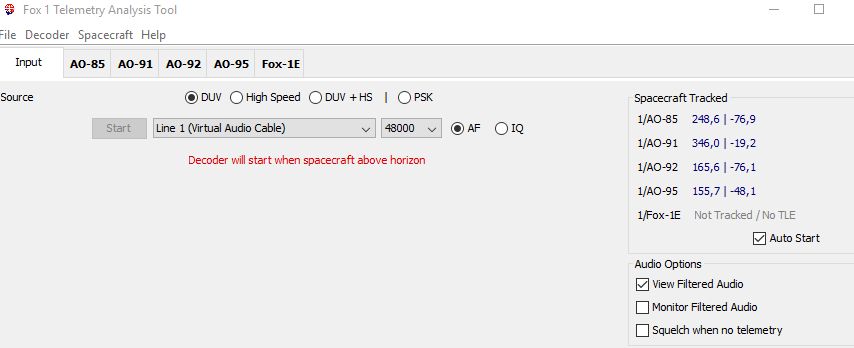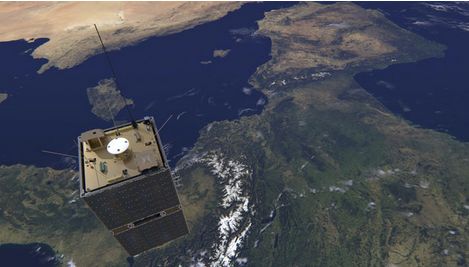From ANS-153:
LightSail is a citizen-funded project from The Planetary Society.
This cubesat will be propelled solely by sunlight, to Earth orbit.
LightSail 2 is scheduled to launch aboard a SpaceX Falcon Heavy on
June 22, 2019, and we will attempt the first, controlled solar sail
flight in Earth orbit.
LightSail 2 will ride to space aboard the Department of Defense
Space Test Program-2 (STP-2) mission which will send 24 spacecraft
to 3 different orbits. LightSail 2 itself will be enclosed within
Prox-1, a Georgia Tech-designed spacecraft originally built to demon-
strate close-encounter operations with other spacecraft. Prox-1 will
deploy LightSail 2 seven days after launch.
After a few days of health and status checks, LightSail 2’s four
dual-sided solar panels will swing open. Roughly a day later, four
metallic booms will unfurl four triangular Mylar sails from storage.
The sails, which have a combined area of 32 square meters [344 square
feet], will turn towards the sun for half of each orbit, giving the
spacecraft a tiny push no stronger than the weight of a paperclip.
For about a month after sail deployment, this continual thrust should
raise LightSail 2’s orbit by a measurable amount.
LightSail 2 will fly in a 24-degree inclination, 720 km, circular
orbit. At latitudes of 42 degrees north it will reach a maximum
elevation of 10 degrees above the horizon.
Lightsail-2 has been issued an experimental radio license WM9XPA and
transmit on 437.025 MHz. A morse beacon will transmit the callsign
every 45 seconds. A packet beacon will transmit AX.25, FSK 9K6 bps
data.
Beacon information is available at:
http://tinyurl.com/ANS-153-Lightsail-Morse-Beacon
Documentation of the downlink telemetry data structure is posted at:
http://tinyurl.com/ANS-153-Lightsail-Telemetry
Category: Ham Satellite news
Här finner du nyheter om amatörradiosatelliter från hela världen.
Varios ham radio satellites news.

Info from G3VZV:
ESA have just released a new mission update for the ESEO Mission. It can be seen here https://www.esa.int/Education/ESEO/ESEO_mission_updates
We are delighted that the BPSK telemetry transmitter, on our payload, was enabled for a period of just over 200 minutes in orbit!
Although we were not able to announce this activation in advance, more than ten stations around the world successfully received the telemetry on 145.895 MHz and submitted it to the FUNcube Data Warehouse. We are very grateful to them for their support.
Over 50 channels of Real Time and Whole Orbit Data were collected. For example, a number of on-board temperatures are shown in this graph which covers the period from 11:58 to 13:36 UTC
The very last frame received was captured by PQ2HX in Brazil at around 14:17 UTC We are keenly awaiting further possibilities to exercise more of the payload as soon as this becomes possible but, in the meantime, is good to know that all the telemetry channels reported nominal values.
HI,
As part of the migration of the data warehouse to the new server, we are now redirecting all dashboard data submissions to:
http://data.amsat-uk.org (there is no need to change your dashboard settings)
Hence, all information at http://warehouse.funcube.org will no longer be updated.
I will be merginging the scores today at http://data.amsat-uk.org/ranking
(I am at the top of the list because of data migration)
You can search for your site name or order the columns by clicking on the column header. There have been requsts for the existing style of ranking, including age colour, for each satellite. I will be implementing this
in the next couple of days.
If you have lost your Dashboard credentials please visit:
http://data.amsat-uk.org/recover-authcode
Hope you like the new site and and feedback will be welcome.
73 Dave, G4DPZ
On October 29, 2018, the Diwata-2 microsatellite was launched on a
H-2A launch vehicle from the Tanegashima Space Center, Tanegashima,
Japan. Diwata-2 was developed by the PHL-Microsat program now
succeeded by the STAMINA4Space program, and in cooperation with
Tohoku University and Hokkaido University. The satellite carries an
amateur radio payload that has been tested and is now ready for
service.
At the request of the STAMINA4Space program, AMSAT hereby designates
Diwata-2 as Philippines-OSCAR 101 (PO-101). We congratulate the
owners and operators of PO-101, thank them for their contribution to
the amateur satellite community, and wish them continued success on
this and future projects.
73,
Drew Glasbrenner, KO4MA
AMSAT VP Operations / OSCAR Number Administrator
FoxTelem Version 1.07 Released

Chris Thompson has officially released version 1.07 of FoxTelem. A
test version has been out for a while, but it had several issues,
including a lower decode rate than 1.06. That prevented release for
a while. Those issues (and something like 65 other defects) are now
all fixed and this decoder performs better than 1.06. Feel free to
test them side by side and report back if that is not the case for
you. We are always interested in any comparative results.
In addition to defects in FoxTelem 1.06 and earlier versions of
1.07, this also introduces Doppler calculation with automatic
adjustment of the decoder frequency. This is especially useful for
decoding beacons and has been helpful in testing for Fox-1A / AO-85
and Fox-1Cliff / AO-95 which are both in SAFE mode. Decoding from
Doppler takes a bit of configuration to get right. Have a read of
the new sections in the manual or ask for help if you want to give it
a try. There are pros and cons vs “Find Signal” for sure.
Version 1.07 changes the core SDR within FoxTelem to use a
Numerically Controlled Oscillator (NCO) rather than an FFT Filter for
the conversion to base-band. This produces better decodes and will
allow the support of wider bandwidth SDRs in the future. The old
decoder is available still if needed from the settings screen. Read
the manual for details.
Version 1.07 also introduces two new BPSK decoders in advance of the
Fox-1E launch. (Chris has no inside information about when that will
be, but he has the decoder ready Chris also wrote some notes on
the comparison between the two decoders, which you can read if you
are interested in BPSK decoding performance, or just wonder what I do
with my time in the evenings:
http://www.g0kla.com/workbench/2019-03-09.php
The releases are here:
http://amsat.us/FoxTelem/windows/foxtelem_1.07y_windows.zip
http://amsat.us/FoxTelem/linux/foxtelem_1.07y_linux.tar.gz
http://amsat.us/FoxTelem/mac/foxtelem_1.07y_mac.tar.gz
KEY CHANGES in 1.07
- Ability to add a new spacecraft from the menu. You can also
remove them. - Doppler calculation and tracking as an option instead of “Find
Signal” - A better SDR based on a Numerically Controlled Oscillator, ready for
wider SDRs - Two new PSK decoders – Costas Loop and Dotproduct
- RTL dongle implemented for testing, though more work to do
- Stops downloading keps when position calc is off
- Allows toggling of high speed / DUV display when in auto mode
- Fixed plotting issues for Earth plots
- Fixes several crashes and bugs
- Fixes copy paste issues with tables
- Respects left/right audio preference when processing wav files
- Implements formats for later spacecraft – Fox-1E and HuskySat
- Linux and Mac launch script updated to locate the JVM (especially on
Mac). Please report if when this works/does not work - MEMS gyro calibration updated
- Fixed a bug where AO-85 data from the server could not be stepped
through
And many other bug fixes. Full list of changes here:
https://github.com/ac2cz/FoxTelem/milestone/12?closed=1
Let Chris know any feedback, chrisethompson (at) gmail (dot) com.
[ANS thanks Chris G0KLA / AC2CZ for the above information.]
ESEO Commissioning starts

From FUNCube website:
On Monday
December 3rd 2018, the 50kg ESA Education Office satellite ESEO was launched by
Space-X on the Spaceflight SSO-A SmallSat Express mission.
Following the launch from Space Launch Complex 4E (SLC-4E) at Vandenberg Air Force Base, ESEO separated from the launch vehicle and automatically activated the periodic transmission of its telemetry beacon. However, by the time out of a predefined period, having not received commands from the ground station, the spacecraft automatically entered into safe mode.
Some initial communications issues were experienced by ESEO in receiving
commands from the ground stations in Forli’ (Italy) and Vigo (Spain), but they were resolved when the ESEO team of the Observatory of Tartu offered the possibility to use a ground station in Estonia. This is capable of transmitting with higher power, for a temporary contingent use. The Estonian ground station has been configured to be operated remotely by the ESEO MCC team, which involves students of the University of Bologna.
ESEO then started executing the commands transmitted from ground.
ESEO has now completed the LEOPS (Launch and Early OPerationS) phase
of its mission, reaching the platform nominal mode and has begun the
process of commissioning the whole satellite: firstly the platform
functions, with the payloads functions following.
As part of
this commissioning process, but subject to the successful completion of
other preparatory tasks of the platform subsystems commissioning, it is
anticipated that initial testing of the AMSAT communications payload
will be carried out within the next few weeks.
AMSAT-UK will
endeavour to provide some advance notice of these tests being
undertaken, but the first step will be activation of the 1200bps BPSK
telemetry beacon on 145.895MHz. The telemetry format matches previous
FUNcube missions and data from this beacon will be forwarded to the
FUNcube Data Warehouse using any of the FUNcube dashboards. However, to
see the decoded values and graphical displays, please download the
dedicated ESEO mission dashboard which is available here https://download.funcube.org.uk/ESEO_Dashboard_v1177.msi
The payload has, additionally, a high speed, 4800bps BPSK data format
downlink and also a Mode L/V FM transponder both of which will be
tested.
Further information about ESEO can be seen here: https://www.esa.int/Education/ESEO/ESEO_student_satellite_in-orbit_commissioning_has_started
